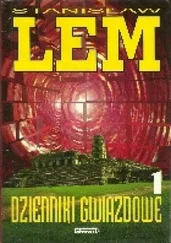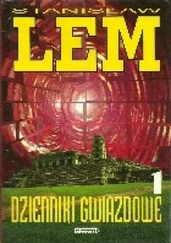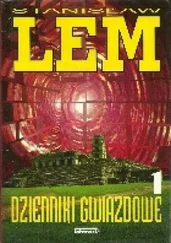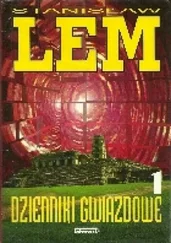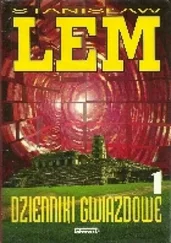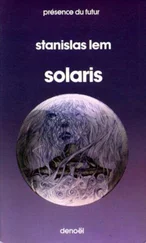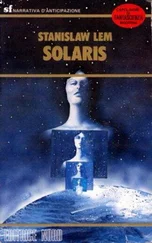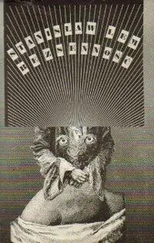“What is?”
“That’s what I don’t know.”
“So we stay here? You reckon a means’ll be found…”
He looked at me, scrawny, the skin on his wrinkled face peeling.
“Who knows? Maybe it’ll be worth it,” he said finally. “We’re unlikely to learn anything about it, but maybe about ourselves…”
He turned, picked up his papers and left. I wanted to stop him, but my open mouth made no sound. There was nothing to be done; I could only wait. I went up to the window and looked out at the blood-black ocean without really seeing it. It occurred to me that I could lock myself in one of the rockets at the docking bay, but I didn’t take the idea seriously, it was too silly — sooner or later I’d have to come out. I sat down by the window and took out the book Snaut had given me. There was still enough light; it turned the pages pink, while the whole room glowed red. The book contained a number of articles and studies, mostly of very dubious value, collected by one Otto Ravintzer, M. Phil. Every science comes with its own pseudo-science, a bizarre distortion that comes from a certain kind of mind: astronomy has its caricaturist in astrology, chemistry used to have alchemy. So little wonder that the emergence of solaristics was accompanied by a veritable explosion of the oddest notions. Ravintzer’s book was filled with this sort of mental matter — prefaced, to be fair, by an introduction in which the editor distanced himself from this house of wonders. He simply believed, not without reason, that such a collection might constitute a record of the times that would be of value both to historians and to psychologists of science.
Berton’s report occupied a prominent place in the book. It consisted of several parts. The first was a transcription of his extremely laconic logbook.
From fourteen hundred to sixteen forty ship’s time, the notes were terse and negative.
Altitude 3000 feet, or 4000, or 2500. Nothing observed, ocean deserted. This was repeated several times.
Then at 16.40: Red mist rising. Visibility 700 yards. Ocean deserted.
17.00: Fog thickening, silence, visibility 400 yards with clearer moments. Descending to 700 feet.
17.20: In fog. Altitude 700. Visibility 20–40 yards. Silence. Climbing to 1300.
17.45: Altitude 1600. Banks of fog to the horizon. In the fog, funnel-shaped openings through which ocean can be seen. Something happening inside them. Attempting to enter one such funnel.
17.52: Kind of whirlpool visible, throwing up yellow foam. Am surrounded by wall of fog. Altitude 300. Descending to 60.
This was the end of the transcription from Berton’s logbook. The next part of the so-called report was an excerpt from his medical history; to be precise, it was the text of a statement dictated by Berton and interspersed with questions from members of the commission.
Berton : When I dropped to a hundred feet, maintaining altitude became difficult, because in the circular space free of fog there were gusty winds. I had to keep a firm hold on the rudder, and for this reason, for some time — perhaps 10 or 15 minutes — I didn’t look out of the cockpit. As a result, I unintentionally entered into the fog, blown there by a strong gust. It wasn’t ordinary fog but a kind of suspension, colloidal in nature it seemed, because it clouded all my windows. I had a lot of trouble cleaning them. The suspension was extremely sticky. At the same time, my rotor speed had been reduced by thirty-some percent because of resistance from the fog or whatever it was, and I began to lose altitude. I was very low and I was worried I’d flip over on the waves, so I gave it full power. The craft maintained altitude, but didn’t rise any higher. I still had four cartridges of rocket boosters. I chose not to use them, thinking the situation could get worse and then I’d need them. At maximum revs the craft began to vibrate badly; I figured the rotors must have gotten covered in the strange suspension. But the load indicators were still showing zero, so there was nothing I could do. I hadn’t seen the sun from the moment I entered the cloud, though the fog was a phosphorescent red in that direction. I was still circling in the hope that I’d eventually come upon one of those holes in the fog, and in fact I did about half an hour later. I climbed into a free zone that was almost perfectly circular, with a diameter of several hundred yards. It was bounded by fog that was swirling dramatically, as if it were being lifted by powerful convection currents. For this reason I attempted to remain as best I could in the center of the hole — that was where the air was calmest. At that time I noticed a change in the surface of the ocean. The waves had almost completely disappeared, and the top of the fluid — the stuff the ocean is made of — had become semi-transparent, with smoky spots that faded away until, after a very short time, the whole thing was completely clear and I could see several yards, I believe, into the depths. Deep down there was a kind of gold-colored ooze that was gathering and sending thin streaks upwards. When it emerged onto the surface it became glassy and shining, it started seething and foaming, and solidifying. At this point it looked like dense burned caramel. This ooze or sludge collected into thick knots, rose up out of the ocean, it formed cauliflower-like swellings and slowly made various shapes. I started being pulled towards the wall of fog, so for a few minutes I had to counter the drift with the engine and the rudder. When I was able to look out again, down below, underneath me, I saw something that resembled a garden. That’s right, a garden. I saw dwarf trees and hedges, paths, none of it real — it was all made of the same substance, which by now had completely hardened, like yellowish plaster. That was how it appeared. The surface glistened brightly. I descended as low as I could to get a closer look.
Question : Did the trees and other plants you saw have leaves?
Berton : No. It was just a general shape — like a model of a garden. Yes, that’s it — a model. That was what it looked like. A model, but a life-sized one, I guess. After a while it all began to crack and break apart. Through gaps that were completely black, a dense sludge rose to the surface in waves and congealed, part trickled down, part remained, and the whole thing began swirling and getting covered in foam, so that now I couldn’t see anything else but it. At the same time the fog began to draw in around me on every side, so I cranked it up and ascended to 1000 feet.
Q : Are you completely certain that what you saw resembled a garden and nothing else?
Berton : Yes. Because I noticed various details: I remember, for example, that in one place there was a row of what looked like square boxes. It occurred to me later they could have been beehives.
Q : It occurred to you later? But not at the moment you saw it?
Berton : No, because it all looked like it was made of plaster. I saw other things as well.
Q : What things?
Berton : I can’t say, because I didn’t get a close look at them. I had the impression that under several of the bushes there were some kinds of tools. They were elongated shapes with protruding teeth, like plaster casts of small gardening implements. But this I’m not entirely sure about. The other thing I am.
Q : Did it not occur to you that this might be a hallucination?
Berton : No. I thought it was a mirage. I didn’t think about hallucinations, because I was feeling absolutely fine, and also because I’d never seen anything like it in my life before. When I climbed to 1000 feet the fog underneath me was pocked with cavities; it looked like Swiss cheese. One of the holes was empty and I could see the waves; in others there was agitation. I descended into one of these places and at a distance of about a hundred twenty feet I saw that under the ocean’s surface — though only just — there was a wall, like the wall of a very large building. It was clearly visible through the waves, and it had rows of regular rectangular openings in it, like windows. I even had the impression that in some of the windows something was moving. That, I’m no longer completely sure about. The wall began to rise slowly and emerge from the ocean. Whole waterfalls of ooze were dripping from it and there were some kind of things made of ooze, sort of grainy condensations. All of a sudden the wall broke in two and sank so quickly it disappeared at once. I brought the craft back up higher and flew right over the fog, so close I was almost touching it with my undercarriage. I saw another empty funnel-shaped place — it was several times bigger than the first one, I believe.
Читать дальше

